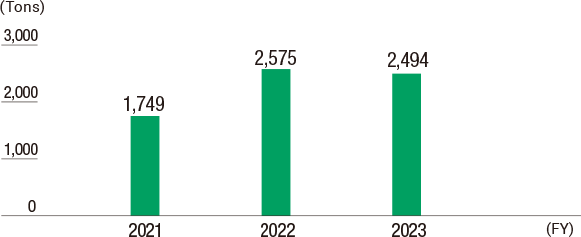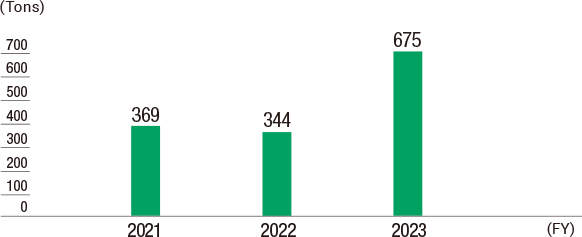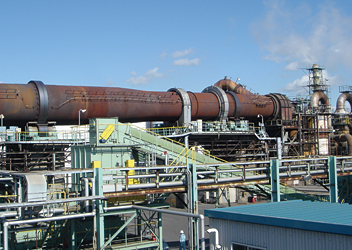Management of Chemical Substances
Basic Approach
Based on laws and regulations such as the Act on Confirmation, etc. of Release Amounts of Specific Chemical Substances in the Environment and Promotion of Improvements to the Management Thereof (Pollutant Release and Transfer Register Act), the ENEOS Group strives to properly manage chemical substances and reduce emissions of such substances. In addition, we are shifting to chemicals with lower impacts on health and the environment.
We are also committed to properly managing chemical substances not covered by these laws and regulations.
Structure
For information on our structure, see Environmental Management.
Major Initiatives
Compliance with Laws and Regulations
Management and Monitoring of Specified Chemical Substances under Japan’s Pollutant Release and Transfer Register Act
The Group manages and monitors the release and transfer amounts of specified chemical substances, such as benzene, toluene, and xylene, which are found in gasoline, based on Japan’s Pollutant Release and Transfer Register Act.
In fiscal 2023, the Group’s releases totaled 2,494 tons, a decrease of 81 tons over the previous fiscal year, and transfers totaled 675 tons, an increase of 331 tons over the previous fiscal year.
- For information about , see the Editorial Policy.
Release of Specified Chemical Substances

Transfer of Specified Chemical Substances

- Note:
- For detailed data, see Data.
Management and Detoxification of PCB1 Waste
The Group carries out storage notification and systematic treatment of PCB waste based on Japan’s Act on Special Measures concerning Promotion of Proper Treatment of PCB Wastes (PCB Special Measures Act).
JX Nippon Tomakomai Chemical, which has been certified by the Minister of the Environment to provide low-concentration PCB waste treatment, carries out detoxification operations, thereby contributing to compliance with the Stockholm Convention on Persistent Organic Pollutants2.
For more information, see Low-Concentration PCB Waste Detoxification.
- 1Polychlorinated biphenyl (PCB): Due to its excellent electric insulation properties, this chemical compound was used mainly in applications such as insulating fluids for transformers and capacitors, and carbonless copiers. However, its production and import are now prohibited.
- 2A treaty regulating the production, use, and proper treatment of persistent organic pollutants, including PCB
Compliance with Domestic and International Regulations
Laws and regulations on the handling of chemical substances are being developed both in Japan and abroad to protect the environment, as well as safety and health. There are also cases where countries have newly implemented chemical substance registration systems or modified existing ones.
The Group takes necessary steps, such as registering substances in chemical substance registration systems in accordance with regulations in Japan and abroad, including the REACH Regulation in Europe and the Act on the Regulation of Manufacture and Evaluation of Chemical Substances in Japan.
Guidelines on Chemical Substances in Our Products and Management of Chemical Substances
ENEOS has voluntarily established standards for managing the chemical substances used in its products. We have specified prohibited substances (such as most organochlorine compounds, mercury compounds, lead compounds, and phthalates) and substances that require monitoring (such as VOCs including toluene, xylene and the like) to better manage their use in products, and we are working to mitigate any harmful effects they may have.
In addition, we provide essential product safety information to customers and others involved with our products using methods such as safety data sheets (SDS). In the event that we obtain new information about any hazards or environmental impacts of our products, we promptly update the relevant SDS to provide the latest information to customers and others.
Businesses that Contribute to Appropriate Management of Chemical Substances
Low-Concentration PCB Waste Detoxification

Since March 2014, when JX Metals Tomakomai Chemical received certification from the Minister of the Environment as the first low-concentration PCB waste detoxification facility in Hokkaido, the company has been working to improve its treatment capacity.
A deadline of March 31, 2027 has been prescribed by law for disposal of waste materials containing PCB. By that date, the owner must either dispose of such materials or have their disposal handled by an agent. However, there are only 25 incineration facilities in Japan, including JX Metals Tomakomai Chemical, capable of detoxifying not only low-concentration PCB waste materials but also the transformers, drums, and other housings that contain them, and there are eight companies that perform decontamination by means of cleaning processes. We are proceeding with the disposal of PCB waste with the aim of completing the disposal by the deadline.
Moving forward, we will maintain stable operations for the treatment of industrial waste as part of our efforts to contribute to the environmental conservation of local communities.
Process for Complete Detoxification of Low-Concentration PCB Waste

Changes Since Initial Certification
| Treated items | Treatment capacity | |
|---|---|---|
| March 2014 (certification by Minister of the Environment) |
|
Solids: 6 tons/day (3 batches of 2 tons each) Waste oil: 8.4 kL |
| March 2015 | Waste materials from outside Hokkaido can be accepted without the need for advance consultation with local governments | |
| September 2015 (additional certification by Minister of the Environment) | Increased size of objects that can be treated Width: 2.5 meters / Depth: 1.5 meters / Height: 2.3 meters |
|
Additional treated items
|
Increase in treatment capacity Solids: 12 tons/day (3 batches of 4 tons each) |
|
| March 2018 (certification by Minister of the Environment) | Additional treated item
|
|
| September 2018 (certification by Minister of the Environment) | Increase in treatment capacity Solids: 13.7 tons/day Waste oil: 9.4 kL |
|